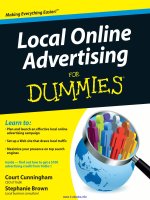Online Advertising Business 101 ppsx
Bạn đang xem bản rút gọn của tài liệu. Xem và tải ngay bản đầy đủ của tài liệu tại đây (145.35 KB, 5 trang )
Online Advertising Business 101, Part I - The Online Advertising Value Chain
When you spend as much time as I do examining the workings of the online ad industry, it's easy
to forget that, to many people, it really is pretty opaque (mờ mịt). Not only is it characterized
(đặc trưng hóa) by some of the most complex and scalable (expandable/improvable) technology
in the world, but it also has its own, pretty unique, economic model to boot (khởi động).
I've lost track of the number of times I've been asked by people, even super-smart colleagues
from within Microsoft, "so, how does the online ad industry actually work?" So I thought I
would attempt to provide a bit of a primer (means: a little Infor- mồi) through the medium of this
blog. Who knows, maybe someone will read it and offer me a book deal
In this first installment, I'm going to take a look at what I call the online advertising value chain:
This is a simplistic view of the industry, but it does enable us to understand where the key
players sit; on the DEMAND SIDE of the value chain, there are advertisers, and their agencies;
and on the SUPPLY SIDE, publishers, and ad networks (and/or ad exchanges).
What's the product?
Before I get onto the content of the boxes in the above diagram, though, we should be clear about
what's in the arrows; that is, what's traded in this market? What's the actual product, here?
The answer is advertising inventory. There are no very good definitions of advertising inventory
out their on the Internet (Dave Chaffey offers one of the better ones), so I offer my own
definition:
Advertising inventory is the supply of opportunities to display advertising in a particular
medium.
Most people would use the term "ad impression" instead of "opportunity to display" - the reason
I haven't is because I don't like to offer a definition of a term which contains another term that
you may need to go and look up. The most common definition of ad impression is this:
An ad impression is a single viewing of a single ad by a single individual.
(Another reason I didn't use it is because it fails to capture the increasing complexity in ad
inventory as online advertising evolves. For example, if you're serving video ads, and the user
watched half of your 30-second pre-roll ad, was that an ad impression?)
In our value chain above, it's the Publishers who are the creators of advertising inventory. By
building websites or software apps or video games or e-mails which are seen by lots of people,
and inserting ads into these environments, publishers create a constant stream of ad inventory
which, of course, they are looking to sell to advertisers. Agencies and Networks merely help the
process along.
Online ad inventory is a very interesting type of good (to use the economics term). It has an
incredibly short shelf life (measured in milliseconds as a page loads), but its supply is only
indirectly under the control of publishers; external factors (such as a very newsworthy event) can
dramatically impact the amount of inventory that a publisher has to offer. As a result, inventory
prediction is a major task for publishers; I'll be returning to this topic in a future installment.
Calculating ad inventory
Another useful way of understanding ad inventory is to look at a simple example of how it's
calculated. Imagine a pretty straightforward website (this blog, for example), showing pretty
simple ads, with no fancy auto-refresh stuff going on (i.e. once a page is loaded, the ads don't
change, so for each page impression, you get one batch of ads). How much ad inventory is
created?
The answer to this is dependent on two variables - the number of page impressions on the site,
and the average number of ads per page. So, for example, if my blog generated a million page
impressions per month (I wish), and had an average of 5 ads per page, then the total ad inventory
(if you're just using a simple ad impression model) is 5 x 1m = 5m ad impressions per month.
The Players
Now that we understand what's being traded, let's take a brief look at the major players in the
value chain, and then I'll let you get back to whatever it was you were doing before you started
reading this post.
The Publisher
We've already covered this guy. He's the one with the site, or the game, or the mobile portal, who
is creating ad inventory and wants to sell it to advertisers to provide income for his business.
Publishers are interested in maximizing revenues, but also at minimizing risk - they hate to have
unsold inventory (that is, ad space with no ads in it) so they employ a number of tactics to ensure
that at least something gets shown in an ad unit that they can get a
little money for.
Larger publishers have their own sales teams who maintain direct
relationships with advertisers and their agencies, cutting deals for
big blocks of advertising inventory over expensive lunches in chic
Greenwich Village restaurants. But this model only works for big
publishers selling to big advertisers. Small publishers can't afford to
maintain their own sales force, and even if they did, they'd never
get through the doors of Ford, or CapitalOne, because they don't have enough inventory to be of
interest on their own account. So these guys sell their ad inventory through Ad Networks.
One other kind of publisher it's worth calling out here is the search engine - i.e. Google, Yahoo
and Microsoft. These search engines are the creators of huge amounts of ad inventory that is sold
directly to advertisers and agencies, as well as running significant ad networks (see below).
The Ad Network
Ad Networks are essentially outsourced sales houses for publisher inventory. An ad network
strikes deals with lots of publishers for their inventory and then aggregates this inventory and
sells it on to advertisers and agencies. There are over 300 ad networks in existence today - a
breathtakingly large number which is sure to fall soon.
An ad network's value proposition to publishers is that it can sell inventory that
the publisher can't sell itself - either because the publisher is small (and so
doesn't have its own sales force), or, in the case of larger publishers, the
inventory is of too low-value to merit direct selling. This kind of inventory is
called remnant inventory.
The network's value to an advertiser is that the advertiser can appear on lots of
sites across the Internet (potentially thousands) without having to establish direct relationships
with those publishers individually.
At bottom, the Ad Network business model is to buy inventory cheaply and sell it on at a higher
price. There are a variety of ways of doing this, some of which I've covered before. One of the
most promising is to add value to the ad inventory by adding targeting data (so that the
impression can be sold for a higher price). I'll cover this in a future installment.
Networks come in all shapes and sizes. There are 'premium' networks which work with remnant
inventory for large publishers; there are vertical networks which focus on a particular industry or
technology (such as video); and, at the bottom end, there are contextual networks which provide
an auction-based marketplace for selling keyword-based ads on small sites. You may have heard
of the #1 network in this space - it's called Google AdSense.
The Advertiser
Advertisers also come in all shapes and sizes, of course. The big name advertisers - the folk
we've all heard of - will have significant internal marketing departments, and will also likely
retain the services of an agency to help them manage their marketing. Their marketing objectives
will likely be a mix of brand marketing (raising general awareness) and direct response
marketing (getting someone to actually buy something online now).
Smaller online advertisers are almost always focused on direct-
response - getting someone to click and buy, or possibly call up. By
and large, these folk can't afford to retain an agency to do their
marketing for them, so they tend to go straight to certain ad
networks or publishers to buy their ads. Again, the #1 in this space
is our friend Google, with AdWords (the advertiser-facing side of
the AdSense network).
Advertisers are motivated by getting the best ROI on their ad investment; but amongst larger
advertisers some other curious motivations creep in, like wanting to make sure that a committed
ad budget for a quarter actually gets spent (so that budget isn't cut the following quarter). This
drives the behavior of ad agencies, to an extent.
The Agency
Last but by no means least, the media agency is an essential intermediary in the advertising value
chain. Ad agencies usually do one of two things (or both, such as is the case with our own
Avenue A|Razorfish): they create ads (anything from designing an animated banner to filming a
30-second TV ad) - known as the creative business - and they buy the media (i.e. the ad
inventory) to display the ads (known as the media business). Whilst the creative side is cooler,
the part of ad agencies that is relevant here is the media business.
A media agency, then, is one that buys media on behalf of its
advertiser client. The advertiser typically says "I have x million
dollars this quarter for online, and this campaign I want to run. Buy
me the best media to reach my target audience". It's then the media
agency's job to plan a media buy that will deliver the best return for
the advertiser.
At the small-business end of the spectrum, the 'media agency' morphs into small SEM (Search
Engine Marketing) shops who are good at buying Google AdWords, and maybe have some SEO
(Search Engine Optimization) skills to boot to boost a company's natural search rankings.
Media agencies' motivation is driven by getting as much media under their control as possible,
since they're paid (particularly at the high-end) with a cut (usually something like 15%) of the
advertiser's media budget. They also don't want to under-spend on the budget they've been given,
as this can annoy their client (see above).
Media buying is a manual, labor-intensive process right now, and one I'll come back to.
Improvements to technology will mean that agencies (especially larger ones) will have to do
some pretty fancy footwork to continue to add value for their advertiser clients.
That's it for now. in future installments, I shall be looking at the key players in a bit more detail,
and looking at some of the interesting economics which underpin the industry. In the meantime,
if you have a comment, or something you'd like me to cover, leave a comment.









